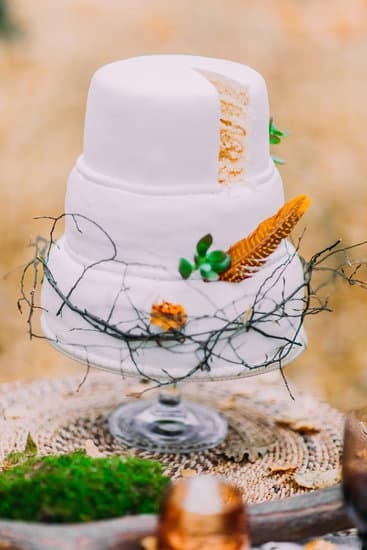Properly storing a cake before decorating is essential to ensure that your final product looks and tastes its best. The way you store a cake can have a significant impact on its presentation, freshness, texture, and flavor. Whether you are working with an unfrosted cake or one that is already frosted, knowing the best practices for storage is key to achieving delicious and visually appealing results.
Improper storage can lead to a dry, stale, or even spoiled cake, ruining all your hard work in the baking and decorating process. Factors such as exposure to air, temperature fluctuations, and improper wrapping can all affect the quality of your cake. By understanding why proper storage matters and following the right techniques, you can preserve the integrity of your cake and ensure it remains delectable until it’s ready to be served.
In the upcoming sections, we will delve into the importance of proper cake storage before diving into detailed guides on how to store both unfrosted and frosted cakes. We will also explore how to freeze cakes for future use without compromising their taste or texture.
By learning these best practices and avoiding common mistakes, you can elevate your baking skills and create beautiful cakes that not only look stunning but also taste amazing. Stay tuned for expert advice from professional bakers who will share their insights on successful cake storage techniques.
Why Proper Storage Matters
Proper storage of a cake before decorating is crucial to ensure the final product looks and tastes its best. Neglecting to store a cake correctly can result in a dry, stale, or even spoiled end result. By understanding why proper storage matters, you can elevate your baking skills and impress your friends and family with delicious and beautifully presented cakes.
Here are some key reasons why proper storage matters when it comes to cakes:
- Moisture control: Storing a cake in the wrong environment can lead to moisture buildup, causing the cake to become soggy or develop mold.
- Flavor preservation: Incorrect storage can alter the flavors of the cake, making it taste less fresh and appetizing.
- Texture maintenance: Proper storage helps retain the desired texture of the cake, whether it’s moist and fluffy or dense and rich.
To ensure that your cakes maintain their quality before decorating, here are some best practices for storing unfrosted cakes:
- Wrap the cake tightly in plastic wrap or aluminum foil to prevent air exposure.
- Store the wrapped cake in an airtight container or resealable bag to maintain freshness.
- Keep the cake at room temperature for up to three days or refrigerate for longer shelf life.
By following these simple steps, you can prolong the freshness of your cakes and set yourself up for success when it’s time to decorate them. Experiment with different storage methods to find what works best for each type of cake you bake.
Best Practices for Storing Unfrosted Cakes
Properly storing an unfrosted cake before decorating is crucial to ensure that the final product not only looks good but also tastes delicious. Improper storage can lead to a loss of moisture, resulting in a dry and unappealing cake. By following some best practices for storing unfrosted cakes, you can maintain the freshness and quality of your baked goods until you are ready to decorate them.
One key tip for storing unfrosted cakes is to wrap them properly to prevent them from drying out or absorbing any odors from the surrounding environment. You can use plastic wrap or aluminum foil to tightly cover the cake and keep it fresh. Additionally, make sure to store the cake in a cool, dry place away from direct sunlight or heat sources to avoid any changes in texture or flavor.
Different types of cakes may require slightly different storage techniques based on their ingredients and density. For example, a sponge cake may need less time at room temperature compared to a dense pound cake. Understanding the specific needs of each type of cake will help you determine how long and where to store them effectively. By taking these factors into consideration, you can ensure that your unfrosted cakes stay fresh and tasty until you are ready to decorate them.
When learning how to store a cake before decorating, remember that proper storage not only preserves the taste of your baked creation but also sets the foundation for a beautifully decorated dessert. By following best practices for storing unfrosted cakes, you can enjoy the process of adding decorative touches without worrying about compromised quality due to improper storage methods.
How to Store Frosted Cakes
When it comes to storing frosted cakes, proper handling is crucial to maintaining the visually appealing decoration and delicious taste of the cake. Whether you’re a professional baker or a home baker looking to store a cake before decorating, there are some tried-and-true tips and tricks that can help preserve the integrity of the frosting and design.
Choosing the Right Storage Container
One key element in storing a frosted cake is selecting the right storage container. Ideally, you want a container that is tall enough to accommodate the height of your cake without touching the frosting. A cake dome or a tall plastic container with an air-tight lid can help protect the frosting from getting smudged or damaged during storage.
Refrigerating vs. Room Temperature
The decision to refrigerate or store a frosted cake at room temperature depends on the type of frosting used. Buttercream and cream cheese frostings should be stored in the refrigerator to prevent them from melting or becoming too soft. Fondant-covered cakes can be stored at room temperature, as long as they are kept in a cool, dry place away from direct sunlight.
Preserving Decoration
To preserve the design on a frosted cake while storing it, you can use various techniques. Placing toothpicks strategically around delicate decorations like sugar flowers or fondant figures can help prevent them from getting squished. Using a cardboard box to shield the top of the cake can also prevent any unwanted touching or shifting of decorations.
By following these expert tips for storing frosted cakes, you can ensure that your hard work in decorating a cake doesn’t go to waste. Proper storage techniques will not only maintain the visual appeal of your creation but also guarantee that each slice tastes just as delicious as when it was first made.
Freezing Cakes for Future Use
One important tip for freezing cakes is to allow them to cool completely before wrapping and freezing. This helps prevent condensation from forming inside the packaging, which can affect the texture of the cake. Once your cake has cooled, you can wrap it tightly in plastic wrap or aluminum foil to protect it from freezer burn. For added protection, consider placing the wrapped cake in an airtight container before placing it in the freezer.
When it comes time to thaw a frozen cake, be sure to do so slowly in order to preserve its flavor and texture. Ideally, you should transfer the wrapped cake from the freezer to the refrigerator and let it thaw overnight. This gradual thawing process helps prevent any moisture loss or sogginess in the cake. Once fully thawed, you can proceed with decorating as desired, knowing that your cake will taste just as fresh as when it was first baked.
| Key Tip | Instructions |
|---|---|
| Cool Completely | Allow the cake to cool entirely before wrapping and freezing. |
| Wrap Carefully | Wrap the cooled cake tightly in plastic wrap or aluminum foil. |
| Slow Thaw | Thaw the frozen cake gradually in the refrigerator overnight before decorating. |
Avoiding Common Mistakes
When it comes to storing a cake before decorating, there are several common mistakes that can affect the overall quality and presentation of your creation. It is essential to be aware of these pitfalls and how to avoid them to ensure that your cake turns out just as you envisioned. By following some simple guidelines and best practices, you can prevent any mishaps and preserve the freshness and flavor of your cake.
Moisture Buildup
One common mistake when storing a cake before decorating is allowing moisture to build up inside the storage container. This can lead to a soggy or wet cake, which is not ideal for decorating. To prevent this, ensure that your cake is completely cooled before wrapping it in plastic wrap or placing it in an airtight container. Additionally, consider adding a piece of parchment paper or a paper towel to absorb any excess moisture.
Improper Wrapping
Another mistake to avoid is improper wrapping of the cake. Using materials like plastic wrap or aluminum foil that are not designed for food storage can affect the taste and texture of your cake. Opt for food-safe materials such as plastic wrap specifically made for storing cakes or invest in proper cake storage containers. Make sure the wrapping is tight but not too tight to avoid damaging the delicate structure of the cake.
Temperature Fluctuations
Lastly, temperature fluctuations can also impact the quality of your stored cake. Avoid storing your cake near heat sources such as ovens or stoves, as this can cause the icing to melt or become sticky. Instead, store your cake in a cool, dry place away from direct sunlight and humidity. This will help maintain the freshness and stability of your cake until you are ready to decorate it.
By being mindful of these common mistakes and following best practices for storing cakes before decorating, you can ensure that your final creation looks and tastes its best. Taking the time to properly store your cakes will ultimately contribute to a successful decorating experience and a delicious end result for all to enjoy.
Expert Advice From Professional Bakers
When it comes to achieving the perfect cake for any occasion, professional bakers know that proper storage is key. Storing a cake before decorating can significantly impact its final presentation and taste. Expert advice from seasoned bakers can provide valuable insights on how to ensure your cakes stay fresh and delicious before the decorating process begins.
Professional bakers emphasize the importance of storing unfrosted cakes in a cool, dry place to maintain their freshness and texture. One common practice is to wrap the unfrosted cake in plastic wrap or foil to prevent it from drying out. Additionally, storing the cake at room temperature or in the refrigerator, depending on the type of cake, can help preserve its flavor and moisture until it’s ready to be frosted.
When it comes to storing frosted cakes, professional bakers recommend using a cake box or dome to protect the frosting and decorations. Be mindful of temperature changes and avoid placing the cake near heat sources or in direct sunlight to prevent smudging or melting of the frosting. By following these expert tips for storing frosted cakes, you can ensure that your decorations stay intact and look as beautiful as when they were first created.
Conclusion
In conclusion, properly storing a cake before decorating is crucial in ensuring the final presentation and taste of the cake. The way a cake is stored can significantly impact its freshness, texture, and flavor. By following best practices for storing both unfrosted and frosted cakes, you can preserve the integrity of your creation and maintain its quality until it’s ready to be decorated and enjoyed.
When it comes to storing unfrosted cakes, it’s important to consider factors such as wrapping, temperature, and duration. Each type of cake may require slightly different storage methods, so be sure to follow specific guidelines for best results. Similarly, when storing frosted cakes, remember to take extra precautions to prevent smudging, melting, or compromising the design. Proper storage techniques can make a difference in how your cake looks and tastes when it’s time to serve.
Whether you choose to freeze a cake for future use or simply store it in the refrigerator or at room temperature, avoiding common mistakes like moisture buildup or improper wrapping is key. By learning from expert advice from professional bakers and following the tips shared in this article on how to store a cake before decorating, you’ll be well-equipped to achieve successful results every time.
So next time you bake a cake, remember the importance of proper storage techniques for a delicious and visually appealing treat.
Frequently Asked Questions
What Is the Best Way to Store Cake Before Frosting?
The best way to store a cake before frosting is to let it cool completely on a wire rack. Once cooled, you can wrap it tightly in plastic wrap or aluminum foil to prevent it from drying out. Storing it at room temperature is ideal to maintain its moisture.
How Do You Keep a Cake Moist Overnight Before Decorating?
To keep a cake moist overnight before decorating, you can brush simple syrup over the layers or cover the cake with a damp tea towel. This will help seal in the moisture and prevent the cake from drying out while you prepare to decorate it the next day.
Should I Put Cake in Fridge or Freezer Before Decorating?
It’s generally recommended to put a cake in the fridge rather than the freezer before decorating, especially if you plan to frost and decorate it within a day or two. Chilling the cake will make it easier to work with as firmer cakes are less likely to crumble or tear when applying frosting.
Just be sure to let it come back to room temperature before serving for the best texture and flavor.

Welcome to our cake decorating blog! My name is Destiny Flores, and I am the proud owner of a cake decorating business named Cake Karma. Our mission is to provide delicious, beautiful cakes for all occasions. We specialize in creating custom cakes that are tailored specifically to each customer’s individual needs and tastes.





